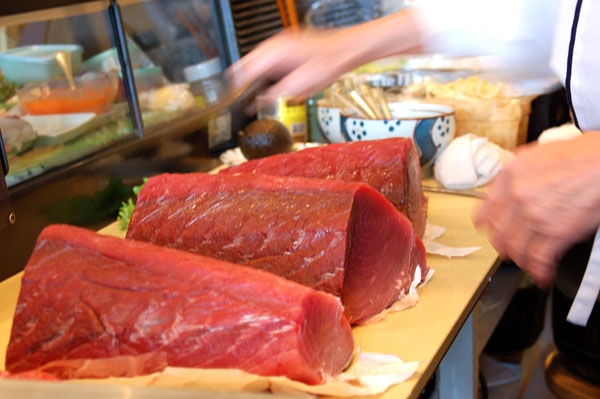For Sushi Yasuda, the exalted Midtown shrine to the pristine purity of raw sliced fish, posting anything less than the top grade of A from the city Department of Health and Mental Hygiene would seem like a skull and crossbones in the window.
But every time they pick up a knife, the restaurant’s chefs ignore the health code and risk seven inspection points — halfway to a B grade — by preparing food the way they believe it must be.
They make sushi bare-handed (washing their hands 40 times during the average dinner service) even  though the city requires food handlers to wear gloves at all times.
though the city requires food handlers to wear gloves at all times.
“Of course we want diners to be protected, and we know the department of health has a monumental challenge,” said Scott Rosenberg, one of the restaurant’s owners. “But the craft of sushi requires a degree of precision and exactitude in making thousands of cuts — microslicing with speed, and in quantity — and the use of gloves makes that impossible.”
“We can get cited for it,” said Mr. Rosenberg, whose restaurant has an A despite a July demerit for barehanded slicing, “but we don’t use gloves.”
Glenn Collins of the New York Times writes that even as chefs and operators strive to avoid the stigma of earning less than an A rating, they navigate a gray area, balancing fidelity to their training and culture with adherence to health regulations. Many veterans of the city’s food wars find that the most intractable, agita-provoking problems are not such egregious violations as rodents, insects and filth, but subtler matters like handling food properly, or keeping and serving it at the required temperature.
Andrew Carmellini’s SoHo restaurant the Dutch has an A, and he cooks chicken the way he thinks is right, though the city specifies an internal temperature of 165 degrees.
“The formal temperatures are too high and make for a dry product,” Mr. Carmellini said. “You get a piece of cardboard that way. For chicken and pork, 165 degrees is too much, and I would prefer to cook it at a lower temperature for a longer time.”
And so he does, legally, when customers specify that it not be well done, and he has not received any 10-point violations for doing so. “But not every inspector is aware of the regulations,” he said.
Daniel Kass, a deputy health commissioner, said that the department’s regulations are based on  “independent analysis regarding the state of the science, federal guidance and state rules, and then a determination is made about what is safe.”
“independent analysis regarding the state of the science, federal guidance and state rules, and then a determination is made about what is safe.”
Mr. Kass said the health department adhered to the New York State sanitary code, which specifies 165 degrees for poultry and pork, but “does not prevent a restaurant from serving undercooked meat to patrons who request it.”
He added: “When the department’s review of the science shows that lower temperatures are safe, it works with the state to try to change the rules.”
